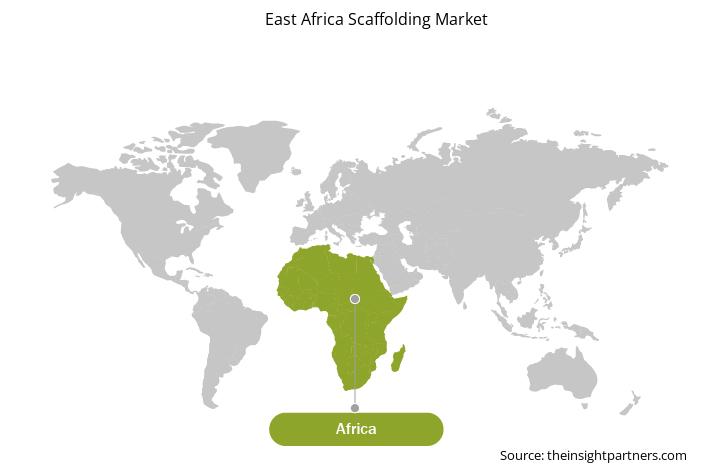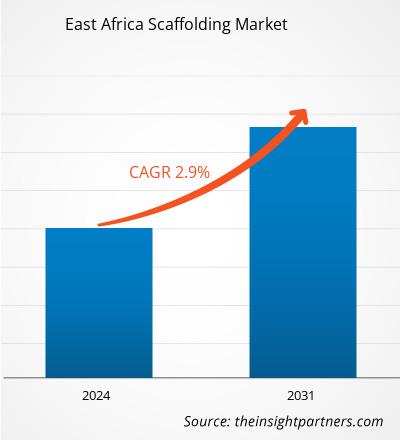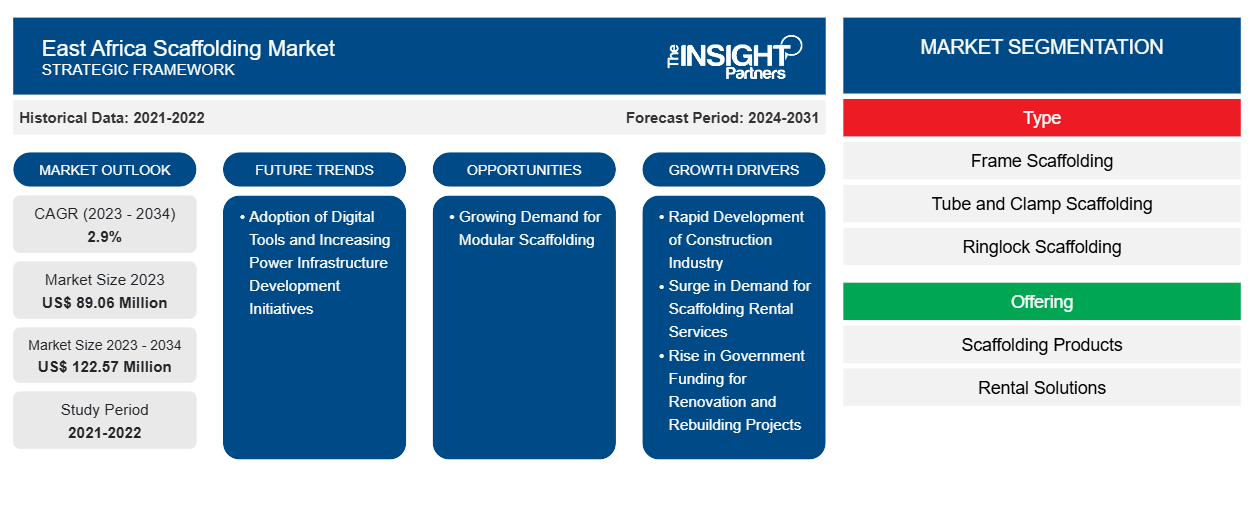预计到 2034 年,脚手架市场规模将从 2023 年的 8906 万美元增至 1.2257 亿美元。预计 2023-2034 年市场复合年增长率为 2.9%。模块化脚手架需求的不断增长可能会在未来几年为市场带来新的关键趋势。
脚手架市场分析
推动东非脚手架市场发展的关键因素包括建筑业的快速增长 、脚手架租赁服务需求激增以及政府对翻新和重建项目的资金增加。然而,高额的初始投资和替代品的存在阻碍了东非脚手架市场的增长。此外,预计在预测期内,数字工具的采用和能源基础设施开发项目的增加将为在东非脚手架市场运营的主要公司创造机会。此外,预计模块化脚手架需求的增长将成为 2023 年至 2034 年东非脚手架市场的主要趋势。
住宅和商业建筑需求的不断增长以及翻新和改造活动支出的不断增加,对东非脚手架市场的增长产生了积极影响。历史建筑的修复需要精细的工作才能保留其原有的特征。脚手架提供了一种安全且侵入性最小的修复和维护方法,而不会损害建筑物的完整性。东非各国政府正在积极推动房地产发展,推出税收优惠、促进财产登记和优先考虑经济适用房等举措。这些措施旨在促进建筑行业的本地和外国直接投资。
脚手架市场概况
东非脚手架市场分为坦桑尼亚、乌干达、卢旺达、肯尼亚和东非其他地区。由于住宅、商业、工业和其他部门对脚手架产品和租赁服务的需求增加,预计东非脚手架市场在预测期内的复合年增长率将达到 2.9%。东非许多国家都致力于通过建设基础设施 和住宅区来发展土地和经济。近年来,受快速城市化、基础设施发展和战略投资的推动,东非建筑业一直在增长。建筑业是该地区脚手架的主要终端用户之一。这些涉及脚手架的建设项目包括道路建设、机场升级、港口设施修复、石油和天然气管道基础设施、上游炼油厂建设和可再生能源项目等。
定制此报告以满足您的需求
您可以免费定制任何报告,包括本报告的部分内容、国家级分析、Excel 数据包,以及为初创企业和大学提供优惠和折扣
- 获取此报告的关键市场趋势。这个免费样品将包括数据分析,从市场趋势到估计和预测。
脚手架市场驱动因素和机遇
建筑业快速发展
住宅和商业综合体需求增加、政府举措增多以及住宅、商业和工业环境中高层建筑增加是促进建筑业增长的一些因素。一些建筑项目包括住宅楼、商业综合体、基础设施开发和工业设施。根据非洲开发银行的报告,预计东非将在 2023 年实现 5% 的平均实际 GDP 增长率,超过整个非洲的预期。东非目前总人口为 4.8 亿,预计到 2050 年将增加一倍以上。
根据联合国人居署的数据,乌干达的城市化增长率居世界首位,约为 5.7%。因此,对支持政府经济适用房计划的公寓大楼和封闭式社区的需求很高。商业、零售和工业部门也在经历显着增长,这得益于中产阶级的不断壮大和消费者支出的增加。为了满足消费者对各种商品和旅游业日益增长的需求,购物中心、办公楼、酒店和餐馆的建设有所增加。埃塞俄比亚、坦桑尼亚和肯尼亚是专注于建筑业发展的顶级国家。根据肯尼亚国家统计局的数据,该国建筑产值在 2022 年增长了 4.1%,达到 172.9 亿美元,该行业对国内生产总值 (GDP) 的贡献率为 7.1%。因此,建筑业的快速发展推动了东非脚手架市场的增长。
采用数字化工具
数字化在各个行业中都得到了显著发展,尤其是在建筑行业。建筑信息模型 (BIM) 等数字工具在该行业得到了广泛应用。BIM 使用户能够创建建筑和脚手架的虚拟 3D 模型。建筑和脚手架的 3D 建模使承包商和建筑公司能够准确规划所需的材料和脚手架类型,从而有助于减少设计中的错误。这可以有效、高效地利用资源,最终降低运营成本。
数字工具提供数据分析和见解,帮助脚手架供应商优化库存管理、资源分配和项目调度。通过利用数字工具和自动化,脚手架制造商和供应商可以提供先进的解决方案,以简化操作、提高安全性并提高整体项目效率。因此,预计在预测期内,脚手架制造商和建筑公司越来越多地采用数字工具,将为东非脚手架市场增长的主要参与者创造丰厚的机会。
脚手架市场报告细分分析
有助于得出东非脚手架市场分析的关键部分是类型、供应和应用。
- 在供应方面,东非脚手架市场分为脚手架产品(销售)和租赁解决方案。租赁解决方案部门在 2023 年占据了更大的市场份额。
- 根据类型,东非脚手架市场分为框架脚手架、管夹脚手架、环锁脚手架、杯锁脚手架和其他传统脚手架。管夹脚手架部分在 2023 年占据了市场主导地位。
- 在应用方面,东非脚手架市场分为住宅建筑、商业建筑、工业、石油和天然气以及活动。商业建筑领域在 2023 年占据了最大的市场份额。
东非脚手架市场区域洞察
Insight Partners 的分析师已详细解释了预测期内影响东非脚手架市场的区域趋势和因素。本节还讨论了东非脚手架市场的各个部分以及北美、欧洲、亚太地区、中东和非洲以及南美和中美洲的地理位置。

- 获取东非脚手架市场的区域具体数据
东非脚手架市场报告范围
| 报告属性 | 细节 |
|---|---|
| 2023 年的市场规模 | 8906万美元 |
| 2034 年市场规模 | 1.2257亿美元 |
| 全球复合年增长率(2023 - 2034) | 2.9% |
| 史料 | 2021-2022 |
| 预测期 | 2024-2031 |
| 涵盖的领域 | 按类型
|
| 覆盖地区和国家 | 东非
|
| 市场领导者和主要公司简介 |
|
东非脚手架市场参与者密度:了解其对商业动态的影响
东非脚手架市场正在快速增长,这得益于终端用户需求的不断增长,而这些需求又源于消费者偏好的不断变化、技术进步以及对产品优势的认识不断提高等因素。随着需求的增加,企业正在扩大其产品范围,进行创新以满足消费者的需求,并利用新兴趋势,从而进一步推动市场增长。
市场参与者密度是指在特定市场或行业内运营的企业或公司的分布情况。它表明在给定市场空间中,相对于其规模或总市场价值,有多少竞争对手(市场参与者)存在。
在东非脚手架市场运营的主要公司有:
- HUGO 脚手架有限公司
- 瓦波脚手架(T)有限公司
- 绍塞承包公司
- 自由活动和合同脚手架有限公司
- Form-Scaff (母公司 - WACO International)
- SA 脚手架集团
免责声明:上面列出的公司没有按照任何特定顺序排列。

- 了解东非脚手架市场的主要参与者概况
脚手架市场份额分析
脚手架市场报告的地理范围提供了详细的国家分析。坦桑尼亚、乌干达和肯尼亚是脚手架市场显着增长的主要国家。坦桑尼亚在 2023 年占据脚手架市场的主导地位,份额为 22.9%;在预测期内,它很可能继续主导脚手架市场。肯尼亚是脚手架市场的第二大贡献者,其次是乌干达。住宅、商业和工业建筑项目对脚手架的需求增加推动了坦桑尼亚对脚手架的需求。根据坦桑尼亚投资中心 (TIC) 的项目注册数据,从 2022 年 7 月到 2023 年 6 月,TIC 注册了 369 个项目,价值 54 亿美元。
政府在交通、制造、建筑、能源和电力等各个领域的基础设施项目开发方面采取的举措和投资增加,预计将在未来几年推动市场增长。东非最有价值的建设项目是坦桑尼亚的 Likong'o-Mchinga LNG 项目。该项目预计价值 300 亿美元,是该国最昂贵的液化天然气工厂。该建设很可能在 2028 年完成。巴加莫约大型港口是坦桑尼亚另一个价值 100 亿美元的项目;它预计将成为东中非最大的港口。
脚手架市场报告覆盖范围和交付成果
“脚手架市场规模和预测(2021-2034)”报告对以下领域进行了详细的市场分析:
- 范围内涵盖的所有主要细分市场的脚手架市场规模和国家层面的预测
- 支撑市场趋势以及市场动态,如驱动因素、限制因素和关键机遇
- 详细的 PEST 和 SWOT 分析
- 脚手架市场分析涵盖主要市场趋势、国家框架、主要参与者、法规和最新市场发展
- 行业格局和竞争分析,涵盖市场集中度、热图分析、知名参与者以及脚手架市场的最新发展
- 详细的公司简介
- 历史分析(2 年)、基准年、预测(7 年)及复合年增长率
- PEST和SWOT分析
- 市场规模、价值/数量 - 全球、区域、国家
- 行业和竞争格局
- Excel 数据集
近期报告
客户评价
购买理由
- 明智的决策
- 了解市场动态
- 竞争分析
- 客户洞察
- 市场预测
- 风险规避
- 战略规划
- 投资论证
- 识别新兴市场
- 优化营销策略
- 提升运营效率
- 顺应监管趋势





















 获取免费样品 - 东非脚手架市场
获取免费样品 - 东非脚手架市场